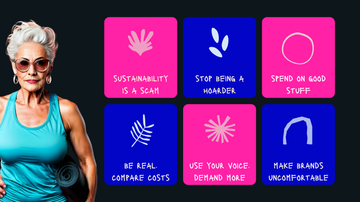Alright, Dutchies, let's talk.
You, me, and the 80% of you who claim to care about sustainability (KPMG, 2023). Yes, I see you. The ones who “always bring a tote bag” but forget it every third grocery run. Don’t worry—this is a safe space.
But if you’re serious about buying sustainably in 2025, you need to get smarter. Because the sad truth? Brands have weaponized your good intentions. That ends today. Welcome to ReadySetGreen’s No-BS Guide to Buying Sustainably in the Netherlands—where we expose scams, decode real trends, and help you stop throwing money at garbage.
1. First, accept that sustainability is a scam (mostly)
Not real sustainability—the kind that actually works is great. 📢 FACT: 73% of Dutch consumers now consider sustainability in their shopping choices (Statista, 2024). Brands know this. That’s why they’re tripping over themselves to sell you products that look green but are really just… well, greenish. Not the RSG brands.
Karen’s checklist for spotting a greenwashing scam:
✅ The packaging is green. That’s it. No real certification, you just have to believe.
✅ It says “biodegradable” but doesn’t tell you how long it takes to break down.
✅ They claim to be “made with recycled materials”—but never tell you how much.
✅ They plant a tree for every purchase (but won’t stop actively polluting).
✅ The words “eco,” “green,” and “sustainable” are all over their website, but zero actual proof.
2. Buy less, buy better, and stop being a hoarder
📢 FACT: The Netherlands aims to halve raw material consumption by 2030 and to be fully circular by 2050 (European Topic Centre on Circular economy and resource use, 2024). That means shifting from a take-make-waste model to reuse-repair-recycle. And guess what? That starts with not buying five different “sustainable” yoga mats when you only use one.
What you can do instead:
✅ Thrift like your grandma. The secondhand market in the Netherlands is thriving and it’s a great way to keep fashion circular. However, not everything you need can be found in a vintage shop. That’s where brands with true sustainability baked into their DNA come in.
✅ Repair and rethink. Your sneakers, your gear, your appliances—if they can be fixed, fix them. But if you’re at the point where repair costs more than the item itself, choose replacements built to last.
✅ Invest in products that last. If your “eco” purchase falls apart in a year, it was never sustainable to begin with. At RSG, we back brands that don’t do throwaway culture. Whether it’s recycled PET caps, closed-loop yoga mats or hemp sneakers, these are the buys that work for you AND the planet.
Bottom line? It’s not about choosing between secondhand or sustainable new—it’s about knowing when to do which.
3. If you’re going to spend, spend on the right stuff
Let’s say you do need to buy something. Where do you put your money? 📢 FACT: 54% of 6.120 surveyed global consumers are now willing to pay a premium for truly sustainable products (Simon Kucher, 2024). But brands know this too, which means they will absolutely overcharge you for nonsense.
Here’s where the real sustainability investments are happening:
✅ Circular fashion – Shoes made from apple leather, sneakers from hemp, and bags from upcycled carbon fiber.
✅ Refillable beauty products – Shampoo bars, solid deodorants, and cosmetics you actually return to be refilled.
✅ Solar-powered gadgets – Your phone charger doesn’t need to be plugged into a wall. Be better.
✅ Water filtration & reusable bottles – Stop buying plastic water bottles. The Netherlands has clean water. Use it.
✅ Second-life furniture & homeware – Instead of filling your house with IKEA sadness, try brands actually making waste-free home essentials.
4. If it costs more, is it worth it?
This is the moment when people say, “But sustainable stuff is soooo expensive.” 📢 FACT: Price is still a major barrier, with 52% of Dutch consumers willing to switch to a more affordable brand if it offers value for money (PwC, 2024). So yes, sustainable shopping can be pricey—if you’re doing it wrong.
Here’s how to make it work for you:
✅ Consider it an investment. A €130 pair of hemp sneakers that last five years beats a €40 pair that falls apart in six months.
✅ Mix secondhand with new. Thrift when you can, but when that’s not an option, choose brands that walk the talk.
✅ Compare costs over time. A €30 shampoo bar lasts 3x longer than a €10 plastic bottle of shampoo. Do the math.
Moral of the story? If you want sustainability to be “affordable,” stop buying cheap crap you’ll replace in six months.
5. Demand more. Call out greenwashing. Make it uncomfortable
You have power. If you keep rewarding companies that greenwash, they’ll keep doing it. 📢 FACT: Consumers spent €12.6 billion on sustainably labeled food products in the Netherlands in 2023—a 14% increase (El Pais, 2024). Sustainable shopping isn’t a trend anymore. It’s an expectation. So start demanding receipts (the metaphorical kind). Ask for real transparency, real data, real circularity. If a brand refuses? Call them out. Loudly.
Be a Climate Karen
Not the annoying kind. The powerful, informed, unshakable kind. The one who sees through fake sustainability stunts and chooses better.
P.S. If you don’t want to miss #TeamClimateKaren updates and social challenges, you might want to start stalking us now on Instagram.



